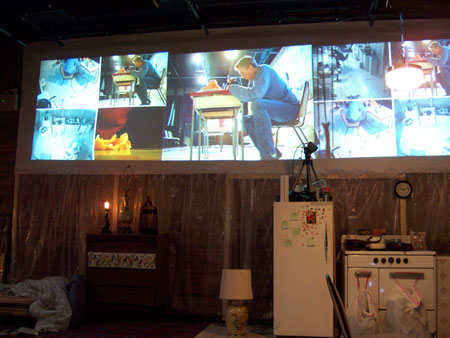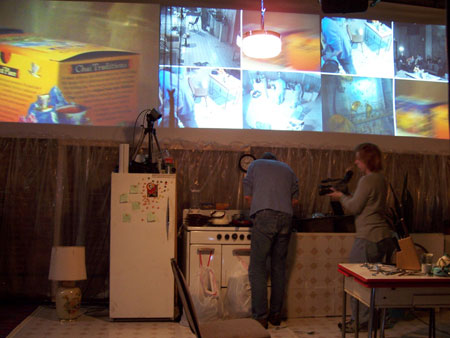Theater
Directed : Doris Mirescu
Cast : Dan Berkey
Soundtrack & music : Michael Attias
Video design & live performance : Alexandra Dementieva
Additional Camera : Richard Gartrell
Sound : Chris Newman
Set and clothes : Oana Botez-Ban
Lights : Lucas Krech
Assistant to the Director : Crichton Atkinson

nytheatre.com review
Martin Denton · March 7, 2008
There is much that is fascinating, artful, and compelling in Doris Mirescu's new theatre piece Madness of Day. But be aware that it is a very long evening of theatre: about two hours and 40 minutes from start to finish, with no intermission.
Based on The Madness of the Day by Maurice Blanchot (as translated by Lydia Davis), the play depicts a day in the life of an unnamed man who is grappling with insanity. We watch him as he wakes and rushes to his bathtub, where getting through his morning ablutions is a significant, harrowing chore: he races away from the tub more than once as spoken and unspoken thoughts haunt him, and he shaves twice—when he does so the second time, he has clearly absentmindedly forgotten or disregarded the first.

Finally he manages to be washed and, still later, dressed. He moves through his day intermittently doing ordinary things like making a cup of tea or feeding his pet bird or watching some TV. But mostly we're aware of the war that's going on inside his head. Patches of normalcy vie with long stretches of discomfiture that sometimes seem to escalate to pure torture. Some of what's going on in there gets communicated via stream-of-consciousness monologue, but the narrative is sketchy and hard to follow, not least because it spills out in ecstatic clumps that come few and far between throughout the 160 minutes we're in his company.
What I took from the piece was a sense for this character's terrible isolation: what must it be like, I found myself thinking, to know you're this close to losing your grip on reality? The advance materials suggest that Mirescu has perhaps more political intentions, but I must confess that I found the work immensely personal and intimate, and my focus stayed squarely on this particular man and his particular awful circumstance.
What's most compelling and noteworthy about Madness of Day is the artistry of its component parts. The set, by Oana Botez-Ban, lays out a cheap but entirely feasible apartment horizontally across the wide playing space of the Paradise Theatre. It is filled with odd details that mirror the text's motifs: birds, food, eggs, and dense, repeated patterns.
Above the set is arrayed a series of screens on which video is constantly projected. There are usually 16 panels but sometimes these combine to form eight or four sections. They are fed by several stationary cameras that are shooting the space live from different pov's plus one handheld camera operated by Richard Gartrell. Gartrell follows the play's sole character around, invisible to him but not to us; the details and images he is able to show us are wondrous and often shockingly beautiful in spite of their mundaneness. The entire video design is by Alexandra Dementieva, and it's extraordinary. In addition to simply giving us lots of stuff to look at while the play's protagonist slowly wrestles with his demons, it supplies much food for thought: what does it mean to be watched? what does it mean to be a witness? (These notions collided whenever I found myself on the screen, which happened more than once as the camera trained on my section of the audience fed the display; then I got caught up in the hypnotic act of watching myself watch...)
Lucas Krech's lighting is meant principally to provide necessary illumination for the cameras, and it does its job well. Michael Attias's music and Chris Newman's soundscape provide invaluable additional layers of rich ambience.
Actor Dan Berkey, one of indie theater's most consistently excellent actors, keeps us riveted throughout; he is in command of this character whose chief attribute is that he's not in command of himself; and Berkey is also astonishingly in command of his own instruments—body and voice—achieving remarkable effects. I was especially impressed by the way he played simultaneously for the live audience and the camera; his performances on screen and on stage, generated by the same actions, often breathtakingly yield surprisingly different results.
Now, I must confess that I found the exquisite parts of this singular multimedia theatrical experiment to be probably more compelling than the piece as a whole; and furthermore that I stopped making new observations about the world created here before the show was even halfway through. 160 minutes is a long time. But there's fascinating work afoot in Madness of Day, and I'm not at all sorry to have had the opportunity to experience it.

Technical description: